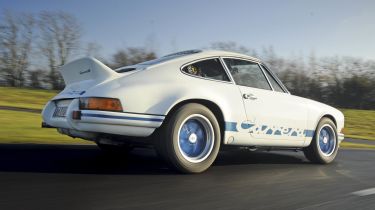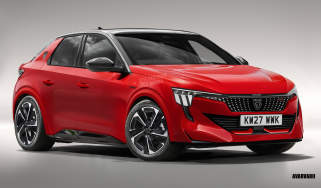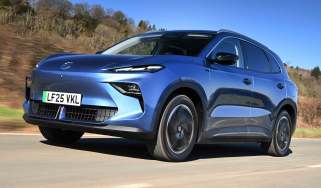Porsche 2.7 RS lightweight
Cabin was stripped out, while distinctive spoiler and decals hint at motorsport pedigree.
Perhaps the most desirable 911 isn’t the original after all – as the later 2.7 RS makes a very compelling case for itself.
Thismodel is widely regarded as one of the finest ever to wear the Porschebadge, and is seen by many as the ultimate performance 911. Motorsporthas always played a large part in the brand’s identity and, with thisparticular machine, the lines between track success and road carperformance started to blur.
To meet motorsport governing bodythe FIA’s Group 4 entry requirements in the early Seventies, 500 roadmodels – near-identical to the racers – had to be built. Such was thedemand for the RS after its 1972 Paris Motor Show debut, though, thatmore than 1,500 were produced.
The first 17 examples off theline were badged RS H (for Homologation); the rest were offered inTouring or Lightweight trims. The latter weighed 100kg less than theTouring, and only 200 were made.
Sound deadening, poweredwindows, rear seats and carpeting were all jettisoned. Light bodypanels and thin glass were added in order to achieve the 975kgkerbweight, making the Lightweight a no-holds-barred performancemachine.
What’s more, engine capacity was increased to 2.7litres, and power rose to 210bhp. As a result, the car was capable ofrocketing from 0-60mph in 5.5 seconds, and reaching a top speed of153mph. All RS variants looked the part, too. The exceptionally rare Hversions had black Carrera decals, while the Lightweight and Touringcould be specified with black, blue, green or red stickers, completewith matching wheel centres. The styling was finished off by anunmistakable rear spoiler and swollen arches.
Used - available now

2021 Tesla
Model 3
29,647 milesAutomaticElectric
Cash £19,100
2020 BMW
1 Series
50,175 milesAutomaticPetrol1.5L
Cash £17,487
2022 Mercedes
E-Class
47,056 milesAutomaticDiesel2.0L
Cash £30,887
2021 Toyota
Corolla Touring Sports
32,261 milesAutomaticPetrol1.8L
Cash £22,497There arethousands of replicas around today, but the car in our pictures is anoriginal Lightweight. It still features the etched markings of thespecialist glazing company which manufactured the unique thin glasswindows.
As with the 911 E, however, one of the RS’s moststriking attributes is its size. The tiny sports car is dwarfed bymodern equivalents, and feels cosy inside. Peer out from behind thewheel and the two headlight humps frame the view.
The 2.7 RSdelivers performance that’s impressive even by modern standards, soit’s no surprise that it inspired the later GT3 RS. The Seventies modelis arguably the Porsche that set in motion the 911’s progression fromgreat road car to one of the finest track machines of all-time.
Today,Porsche Motorsport sells more than 300 racing 911s annually. In 40years, the car has secured more race and rally victories than anyother. Rare, fast and stunning, the 2.7 RS is as thrilling to drive nowas it was three decades ago. That, plus its significance in thesporting history of the brand, makes it easy to see why it gets a placein our top six.
Owner profile Paul Bellis
The owner of the stunning2.7 RS Lightweight in our pictures is Paul Bellis, from Dorset. He wasbewitched by the marque as a child, and has owned five of its cars. Butthere was one model he particularly wanted to get his hands on: the 2.7RS.
“It is the ultimate 911 and, having found one, it takespride of place in my collection. I can see myself owning it forever,”he explains. This left-hand-drive example was bought new by a Germanrally driver. It arrived here in 1980, joining one of the UK’s biggestprivate collections of Porsches. Paul put his name in the logbook twoyears ago, and shows no inclination to hand the car over to anyone else!







